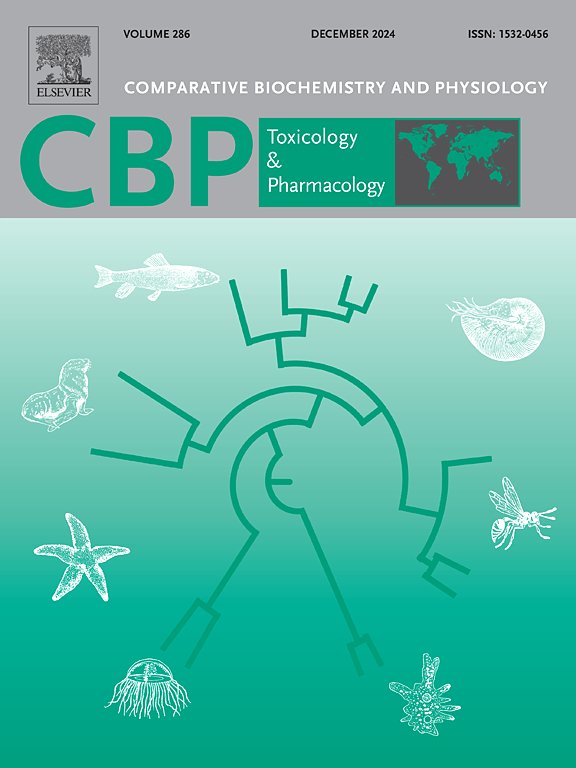Beta-adrenergic blockade via atenolol negatively affects body and heart mass and renal morphology in the developing chicken (Gallus Gallus Domesticus)
IF 3.9
3区 环境科学与生态学
Q2 BIOCHEMISTRY & MOLECULAR BIOLOGY
Comparative Biochemistry and Physiology C-toxicology & Pharmacology
Pub Date : 2024-11-29
DOI:10.1016/j.cbpc.2024.110089
引用次数: 0
Abstract
Atenolol is a widely prescribed β1-cardioselective blocker. We studied atenolol effects on cardiac and renal development in day 18 (D18) chicken embryos. Embryos were dosed with atenolol (3 μg atenolol/g estimated embryo mass) for three days during one of the mesonephric kidney stage (D7-D9), mesonephric-metanephric stage (D11-D13), or metanephric stage (D15-D17), and then sampled on D18. Wet embryo body mass in atenolol-treated groups was reduced at D18 (P < 0.01). Wet heart mass of atenolol-treated embryos was significantly (P < 0.01) reduced in the mesonephric stage on D18. Similarly, kidney mass in atenolol-treated mesonephric and metanephric stages was significantly reduced at D18. Nephron density was 40 % lower following atenolol treatment during the mesonephros stage. Individual glomerular areas of mesonephric- and metanephric-treated stages were significantly larger (P < 0.01) than controls, but overall glomerular area was reduced in the meso- and meso-metanephros populations. Collectively, these data suggest that chronic atenolol treatment results in major renal remodeling and that the mesonephros renal stage (D7-D9), is the critical window for effects of atenolol on renal morphology. Acute atenolol application at D11 through D19 had no effect on mean arterial blood pressure or heart rate, even though these variables were acutely altered as early as Day 15 by isoproterenol. Collectively, these data suggest that the morphological effects of atenolol were not the result of altered perfusion. Further experiments are required to determine if reduced embryo, cardiac and renal masses are specific to chronic atenolol treatment, or whether other β blockers might have similar effects.

阿替洛尔阻断β -肾上腺素能对发育中的鸡(Gallus Gallus Domesticus)的身体和心脏质量以及肾脏形态产生负面影响。
阿替洛尔是一种广泛使用的β1-心脏选择性阻滞剂。研究了阿替洛尔对18日龄鸡胚心脏和肾脏发育的影响。在中肾肾期(D7-D9)、中肾-后肾期(D11-D13)或后肾期(D15-D17)分别给胚胎注射阿替洛尔(3 μg阿替洛尔/g估计胚胎质量)3天,然后在D18取样。阿替洛尔处理组湿胚体质量在D18 (P
本文章由计算机程序翻译,如有差异,请以英文原文为准。
求助全文
约1分钟内获得全文
求助全文
来源期刊
CiteScore
7.50
自引率
5.10%
发文量
206
审稿时长
30 days
期刊介绍:
Part C: Toxicology and Pharmacology. This journal is concerned with chemical and drug action at different levels of organization, biotransformation of xenobiotics, mechanisms of toxicity, including reactive oxygen species and carcinogenesis, endocrine disruptors, natural products chemistry, and signal transduction with a molecular approach to these fields.

 求助内容:
求助内容: 应助结果提醒方式:
应助结果提醒方式:


